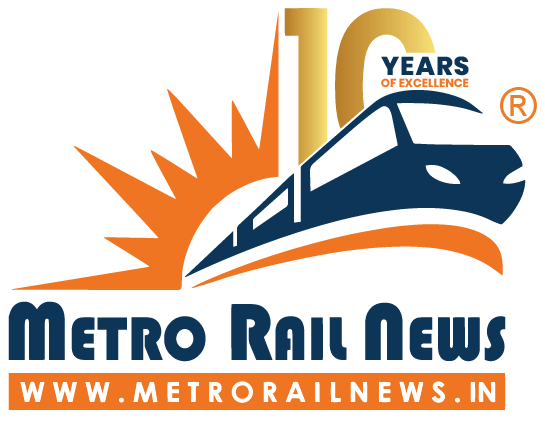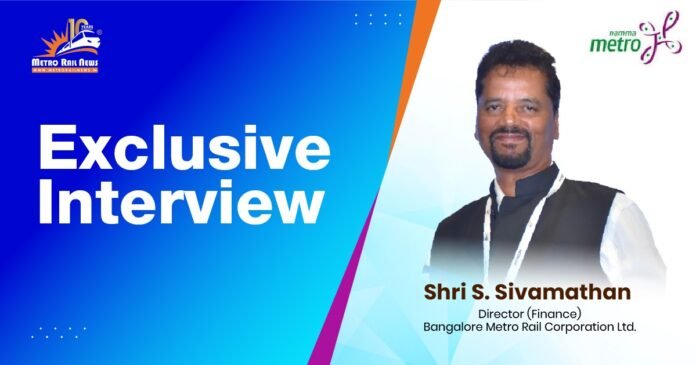Metro Rail News had the privilege of conducting an exclusive interview with Shri S. Sivamathan, who is currently serving as the Director (Finance) and Chief Financial Officer (CFO) at Bangalore Metro Rail Corporation. During the interview, Shri Sivamathan reflected on the progress made in Phase 2 of the Bangalore Metro project. He also mentioned BMRCL’s plan to start operations on the Yellow Line by mid-August. In addition, Shri Sivamathan elaborated on BMRCL’s strategy for loan repayment and leveraging non-fare box revenue streams for additional financial support. Speaking about last-mile connectivity, Shri Sivamathan explained the initiatives being undertaken by BMRCL to make metro stations more accessible for passengers.
Here are the edited excerpts:
Could you please elaborate on your professional journey? How have your years of experience across various metro systems influenced your approach to strategic decision-making at BMRCL?
I started my career with National Fertilizers Limited, where I worked for 16 years. Since December 2005, I have been in the metro rail industry, starting with DMRC for about 11 years, followed by Maha-Metro as Director (Finance) & CFO for 5 years. I have been with BMRCL as Director (Finance) & CFO since September 2021.
My strategic decision-making approach is deeply influenced by my experience working with Dr. E. Sreedharan Sir. His philosophy of doing your duty with a little extra effort, treating contractors as partners (whose success is the company’s success), and resolving issues by putting oneself in the shoes of both contractors and employees has shaped my mindset.
What is the current status of Bangalore Metro Phase 2? What are the crucial deadlines that BMRCL is planning to meet in the coming months, especially for the Yellow Line and Pink Line?
The Phase 2 project is progressing well. We are planning to commission the Yellow Line by mid-August 2025 with three train sets, and thereafter, one or two train sets will be added every month. The Pink Line of Phase 2 is slated for completion by June 2026 (for the elevated section), while the underground section is expected to be completed by December 2026. With this, the entire Phase 2 project is expected to be completed by December 2026.
Bangalore Metro Phase 2 has seen a cost escalation of around ₹14,019 crore. Could you explain the funding mechanism that has been adopted for Phase 2, Phase 2A and Phase 2B?
The approved cost was ₹30,695.12 crore, which has now increased to ₹40,425.02 crore. This escalation is due to several factors: the addition of 258 cars in rolling stock, an increase in the project length by over 3 km, the construction of an additional station and a large depot at Challaghatta. Land costs have also gone up due to revisions in the guidance value by the Government of Karnataka (GOK), as the DPR considered the December 2010 rate.
In addition, PSGs have now been planned for the underground sections, which were not included in the approved DPR. All these changes have led to a cost increase of ₹9,929.90 crore.
As for funding, as per the sanction order, cost increases, excluding exchange rate variations and central taxes, are to be borne by the GOK. We are in discussions with all funding agencies currently supporting the Phase 2 project, and they have responded positively.
What is BMRCL’s strategy regarding debt servicing and repayment of loans taken from multilateral agencies such as JICA, ADB, and AIIB?
Debt servicing is a challenge for every metro rail company. DMRC was able to manage it on its own until about two to three years ago. For the past two years, BMRCL has been meeting its interest obligations from its revenue.
In line with the tripartite MoU signed between the Government of India, the Government of Karnataka, and BMRCL, the GOK is providing interest-free subordinate debt to repay the external loans routed through the Government of India.
Once operational, how will Phase 2 influence the ridership trends for Bangalore Metro?
Once the Phase 2A and 2B projects are completed by December 2027, BMRCL’s ridership is expected to exceed 2 million passengers per day. We are focusing on expanding our non-fare box revenue to supplement fare revenue. With the recent fare revision, I believe BMRCL will be able to meet a substantial portion of its loan repayment obligations from its books, potentially after 2027.
Connecting metro stations with nearby places is paramount for efficient accessibility. What initiatives are being adopted to facilitate first and last-mile connectivity for the passengers?
To increase metro ridership, BMRCL has undertaken several initiatives. BMTC provides last-mile connectivity at most stations. Some stations on the Yellow and Pink Lines are located near corporate offices such as Infosys and Biocon. We’ve entered into long-term semi-naming agreements with some of these companies. Once metro connectivity is operational, these companies plan to distribute NCMC cards (metro travel cards) to their employees, which is expected to boost ridership.
We are also working to provide direct connectivity from metro stations to the offices of a few corporations, which will provide seamless movement of the passengers.
Is BMRCL exploring Public-Private Partnership models for funding operations in any of its phases?
Yes, for the ongoing Phase 2, 2A, and 2B projects, we have PPP arrangements in the form of semi-naming rights for 60 years, which come bundled with several additional rights. We also have a back-ended PPP with Bangalore International Airport Limited (BIAL) for a partial funding amounting to ₹850 crore, plus the cost of two stations that are coming up at the airport in the 2B section.
With the growing focus on digital infrastructure, is BMRCL adopting any digital payment innovations for revenue collection and commuter convenience?
Yes, BMRCL is the first metro rail operator in India to adopt a WhatsApp-based ticket payment solution. Currently, more than 20% of our daily farebox revenue is collected through digital payment modes.
What message would you like to convey to the readers of the Metro Rail News?
Metro Rail News provides comprehensive coverage of Metro Rail and Indian Railways through its online platform and magazine. It not only highlights developments in the rail industry but also focuses on the ecosystem of suppliers and sub-suppliers associated with this sector.






